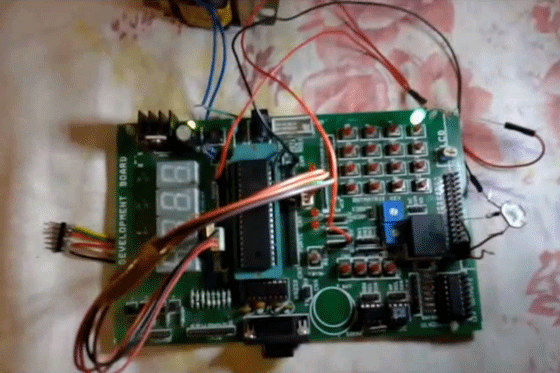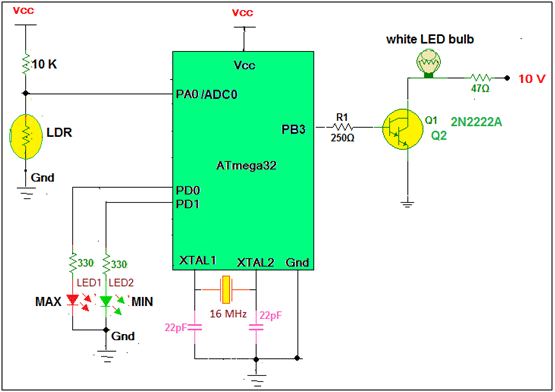Now a days LED light bulbs are becoming more and more popular because they have several advantages. Some of their advantages are listed below
· Their energy (electrical) consumption is much more less
· Their luminance is more
· Their intensity can be varied
· Their life time is more
So if LED lights are used in place of conventional lights we can save much more electrical energy that leads to saving of conventional energy sources like coal, petrol, diesel etc. Also the light intensity of LED can be varied as per ambient light. That is one more plus point in saving electrical energy. We can set the light intensity to required level and get dual advantage of having exact amount of luminous and saving of energy.
So here I am presenting a demonstration of varying LED light intensity as per change in ambient room light using AVR micro-controller. Like, when room light is maximum (during day time) no need of LED light so LED is off but as ambient room light decreases the LED light intensity starts increasing. LED light will be fully ON when room light is very low.It is assumed that the reader has gone through the project How to get started with AVR and done all the things discussed in it.
I have used LDR as light sensor. It senses ambient room light and gives signal to AVR micro-controller. Micro-controller determines this room light and varies intensity of LED light accordingly using PWM method.
Circuit diagram:
Connections: –
· LDR is connected between Vcc and Gnd with fixed value 10 K resistor as shown. 10 K resistor provides bias to LDR
· The LDR junction output is fed to ADC0 input pin of AVR micro controller
· Two LEDs are connected to PORTD pins PD0 and PD1 through current limiting resistors. They indicate max and min LED intensity
· The PWM output pin PB3 is fed to base of Darlington amplifier through 250E current limiting resistor
· Darlington amplifier is made up of two NPN type 2N2222 transistors. It is used to increase the output current of micro-controller
· A 10 V white LED bulb is connected at the output of Darlington amplifier as shown
· A 16 MHz crystal with two 22 pf capacitors is connected to crystal input pins
Operation: –
· During day time when room light is enough the LDR resistance is low. So its output voltage is less. It is converted in to digital value by built in ADC of AVR micro controller
· This digital output is also very low. So LED light bulb is off. Its indicated by GREEN led
· In the evening as room light decreases the LDR resistance increases that leads to increase in its output voltage
· The micro controller start increasing width of pulse fed to LED light bulb. So its intensity gradually increases
· Finally at night when no room light LED bulb intensity reaches to maximum. It is indicated by RED LED

Fig. 1: Prototype of AVR ATMEga16 based Automatic LED Light Controller
Software Program & Further Advancement
Software program:
The operation of the circuit depends upon the program downloaded in to micro controller. The program is written in C language in AVR studio software. It is compiled using AVR simulator available with AVR studio. When program is compiled the HEX file is created. This HEX file is loaded into ATMega16 micro-controller using any suitable AVR programmer. Here is the complete program given with necessary comments.
Further advancement:
Multiple LDR sensors are placed in different places of big room or in different rooms that controls different LED light bulbs placed at different places in room or different rooms.
A separate standalone unit can be made that can be placed at any remote location. The unit includes solar panel, battery, battery charging circuit, LED light bulb, LDR sensors and LED light controller circuit.
Project Source Code
### #include <avr/io.h> #include <util/delay.h> void adcinitliz() // initialize built in ADC { ADMUX = (1<<REFS0); ADCSRA =(1<<ADPS2) | (1<<ADPS1) | (0<<ADPS0); ADMUX=(0<<MUX2) | (0<<MUX1) | (0<<MUX0) ; } unsigned int convert() // convert 10 bit HEX value into { // decimal equivalent unsigned int tmp1,tmp2,tmp3,t; tmp1 = (ADCL & 0x0F); tmp2 = ADCL >> 4; tmp3 = (ADCH & 0x0F); tmp2 = tmp2*16; tmp3 = tmp3*256; t = tmp1+tmp2+tmp3; // and return decimal value return t; } void main() { unsigned int adc_value; DDRB=0x08; // configure PWM pin as output PORTB=0x00; DDRD=0xFF; // PORTD as output PORTD=0x00; TCCR0=0x6B; // configure timer as fast PWM adcinitliz(); // initialize ADC while(1) { ADCSRA = (1<<ADEN) | (1<<ADSC); // give start pulse to ADC while(!(ADCSRA & (1<<ADIF))); // wait for conversion end ADCSRA = (1<<ADIF); adc_value = convert(); // get decimal value if(adc_value<99) // if its too less { TCCR0 = 0x00; // stop timer PORTB = 0x00; // LED light bulb off PORTD = PORTD | 0x02; // green LED ON } else TCCR0 = 0x6B; // start timer else // change PWM width as LDR output (ADC value) changes if((adc_value>=99) && (adc_value<199)) OCR0 = 20; else if((adc_value>=199) && (adc_value<199)) OCR0 = 40; else if((adc_value>=199) && (adc_value<299)) OCR0 = 60; else if((adc_value>=299) && (adc_value<399)) OCR0 = 80; else if((adc_value>=399) && (adc_value<499)) OCR0 = 100; else if((adc_value>=499) && (adc_value<599)) OCR0= 140; else if((adc_value>=599) && (adc_value<699)) OCR0 = 180; else if((adc_value>=699) && (adc_value<799)) OCR0 = 200; else if((adc_value>=799) && (adc_value<899)) OCR0 = 220; else if((adc_value>=899) && (adc_value<999)) OCR0 = 240; else if(adc_value>=999) // if value is max { OCR0 = 250; // set max width for PWM PORTD = PORTD | 0x02; // RED LED ON } _delay_ms(1000); // wait for 1 sec PORTD = PORTD & 0xFC; // both LED off } } ###
Circuit Diagrams
Project Video
Filed Under: Electronic Projects
Filed Under: Electronic Projects



Questions related to this article?
👉Ask and discuss on Electro-Tech-Online.com and EDAboard.com forums.
Tell Us What You Think!!
You must be logged in to post a comment.